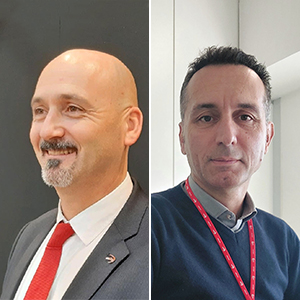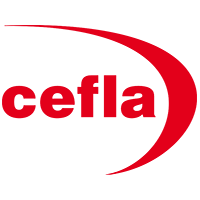
Interview with Lorenzo Melloni and Gianpietro Galeotti
Marketing Manager and New Product Development Manager BU Finishing
Innovation for Cefla > BU Finishing > Product innovation
How have customers been made the focus of the design of IoT innovations (enabling technologies that drive predictive maintenance, time-saving and the shift from product to service) and digital printing on "unconventional" surfaces?
“Our innovative approach to IoT development and design means that the customer is, today, not just the focus of the process but an active participant in it. Our guiding principle is customer-focused simplification. By collating and rationalising daily requests we’re able to map customer’s needs and foster design solutions that respond to specific requirements.
The Finishing BU doesn’t just develop products: it improves manufacturing processes and drives the creation of new ones. Starting with in-depth market analysis, we’re able to identify solutions that respond to customers’ myriad needs
To cope with such a diverse international market, we’ve adopted a multidimensional approach, which might be better defined as a ‘three-dimensional mosaic’.
The first ‘dimension’ is horizontal, the one in which our products and processes are promoted and marketed around the globe. This involves assessing different finishing methods, experiences and cultures in various countries. This first level of the challenge facing us means engaging with both local producers and multinationals.
The second vertical ‘dimension’ is characterised by the depth of market demand: this can range from an entry-level product to the fully integrated finishing lines employed by major international players. To cope with this second level, we deploy an extensive solutions portfolio.
The last and third ‘dimension’ is the multiplicity of industries in which we now operate. From our traditional core market of wood, in which we lead the way in terms of both volumes and technology, we’ve branched out into adjacent fields. To rise to this third-level challenge, we leverage a carefully nurtured mindset based on consolidated professionalism and a rare capacity for innovation.
In moving from wood into other markets, we were forced to make a quantum leap and organise ourselves into Business Lines:
- Furniture & Housing
- Building Materials (plastic, metal, inert materials, glass)
- Automotive/Aerospace
- General Industry
While, in the Furniture & Housing sector, we’re acknowledged technological first movers, in the other three we’re still ‘explorers’, building on our recognized reliability in the coating sector.
In a context of multidimensional complexity, we’re on a path – together with our customers – that leads to the development of products, processes and solutions with one shared goal: to create value and give each customer a competitive advantage.”
How was the innovation designed? Is it possible to take a ‘creative’ approach when experimenting with an innovation?
“When moving into non-wood sectors, we go about creating tangible solutions by taking a scientific approach. Thanks to our corporate set-up and research facility, we’re able to put together a ‘puzzle’ of micro-processes that provide customers with an immediate, tangible response. This is possible because close teamwork with coating manufacturers and customers sparks true ‘creative’ innovation. It’s this ‘symbiosis’ and the right sequence of chemical and physical processes, then, that leads to the creation of new coating solutions.
Innovation in the IoT field provides a cross-sector boost, enabling functions and services that are then added to our product portfolio.
In recent years, company development has shifted its focus from the Product to the Market (i.e. customer). As trailblazers, we focus on the Process, adopting a strategy that involves customers and suppliers alike. “
To what extent has technology influenced the innovation process?
“Technology drives the way we address issues and thus permeates all our solutions. It helps us home in on a result, which often emerges as innovation.”
Does Cefla engage in Open Innovation together with research bodies and universities?
“With DEIX, a spin-off of the Polytechnic University of Rome and Milan, we’re working on a joint project that focuses on digital printing process quality management.
We’re also involved in an ongoing doctorate at Bologna University’s Faculty of Mechatronics to develop a new control system for Cartesian robot axes.
With IDEA – part of the Polytechnic of Marche and the University of Ancona HMI (Human-Machine-Interface) project – we’re looking into robots and operator panels. Drawn up in collaboration with a customer, this project aims to equip machines with sensors that boost quality control by integrating data harvesting into the spraying and drying fields.
Furthermore, we’re committed to “Beyond 2025″, a project that targets AI-related topics. It also explores the drawing up of a ‘skills registry’ to provide in-depth data on the knowledge that resides in people, and explores how best to transmit skills to new generations.”


